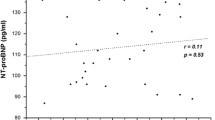Abstract
Objective: Prepregnant low plasma volume (LPV) is associated with subsequent gestational hypertensive disease. It is unknown to what extent an LPV affects the venous reserve capacity (VRC). We tested the hypothesis that LPV reduces the VRC, as indicated by presyncope or altered cardiovascular changes in response to head-up tilt. Study design: In 52 nonpregnant women with a history of preeclampsia or recurrent miscarriage, the authors assessed plasma volume, stroke volume, and cardiac output and determined blood pressure, heart rate, and autonomic responses to stepwise inflicted head-up tilt. Results: 12 participants had LPV, which related to presyncope when compared with subjects with normal plasma volume (NPV). Women with LPV without presyncope demonstrated a circulatory response comparable to NPV women at the expense of consistently higher heart rate. Conclusion: LPV decreases the capacity to cope with head-up tilt without affecting the response pattern, suggesting reduced VRC.
Similar content being viewed by others
References
Sibai B, Dekker G, Kupferminc M. Pre-eclampsia. Lancet. 2005;365:785–799.
Weintraub AY, Sheiner E, Bashiri A, Shoham-Vardi I, Mazor M. Is there a higher prevalence of pregnancy complications in a live-birth preceding the appearance of recurrent abortions? Arch Gynecol Obstet. 2005;271:350–354.
Wilson BJ, Watson MS, Prescott GJ, et al. Hypertensive diseases of pregnancy and risk of hypertension and stroke in later life: results from cohort study. BMJ. 2003;326:845.
Spaanderman ME, Ekhart TH, van Eyck J, Cheriex EC, de Leeuw PW, Peeters LL. Latent hemodynamic abnormalities in symptom-free women with a history of preeclampsia. Am J Obstet Gynecol. 2000;182:101–107.
Spaanderman ME, Van Beek E, Ekhart TH, et al. Changes in hemodynamic parameters and volume homeostasis with the menstrual cycle among women with a history of preeclampsia. Am J Obstet Gynecol. 2000;182:1127–1134.
Courtar DA, Spaanderman ME, Aardenburg R, Janssen BJ, Peeters LL. Low plasma volume coincides with sympathetic hyperactivity and reduced baroreflex sensitivity in formerly preeclamptic patients. J Soc Gynecol Investig. 2006;13:48–52.
Bernstein IM, Shapiro RE, Whitsel A, Schonberg AL. Relationship of plasma volume to sympathetic tone in nulliparous women. Am J Obstet Gynecol. 2003;188:938–942.
Aardenburg R, Spaanderman ME, Ekhart TH, van Eijndhoven HW, van der Heijden OW, Peeters LL. Low plasma volume following pregnancy complicated by preeclampsia predisposes for hypertensive disease in a next pregnancy. BJOG. 2003;110:1001–1006.
Aardenburg R, Spaanderman ME, van Eijndhoven HW, de Leeuw PW, Peeters LL. Formerly preeclamptic women with a subnormal plasma volume are unable to maintain a rise in stroke volume during moderate exercise. J Soc Gynecol Investig. 2005;12:599–603.
Fu Q, Witkowski S, Okazaki K, Levine BD. Effects of gender and hypovolemia on sympathetic neural responses to orthostatic stress. Am J Physiol Regul Integr Comp Physiol. 2005;289:R109–R116.
Kimmerly DS, Shoemaker JK. Hypovolemia and neurovascular control during orthostatic stress. Am J Physiol Heart Circ Physiol. 2002;282:H645–H655.
Brown MA, Lindheimer MD, de Swiet M, Van Assche A, Moutquin JM. The classification and diagnosis of the hypertensive disorders of pregnancy: statement from the International Society for the Study of Hypertension in Pregnancy (ISSHP). Hypertens Pregnancy. 2001;20:IX–XIV.
Hasebe Y, Iriki M, Takahasi K. Usefulness of R-R interval and its variability in evaluation of thermal comfort. Int J Biometeorol. 1995;38:116–121.
Du Bois D, Du Bois EF. A formula to estimate the approximate surface area if height and weight be known. Arch Intern Med. 1916;17:863–871.
Wieling W, van Lieshout JJ, Ten Harkel AD. Dynamics of circulatory adjustments to head-up tilt and tilt-back in healthy and sympathetically denervated subjects. Clin Sci (Lond). 1998;94:347–352.
Hainsworth R, Al-Shamma YM. Cardiovascular responses to upright tilting in healthy subjects. Clin Sci (Lond). 1988;74:17–22.
Harms MP, Wesseling KH, Pott F, et al. Continuous stroke volume monitoring by modelling flow from non-invasive measurement of arterial pressure in humans under orthostatic stress. Clin Sci (Lond). 1999;97:291–301.
Laude D, Elghozi JL, Girard A, et al. Comparison of various techniques used to estimate spontaneous baroreflex sensitivity (the EuroBaVar study). Am J Physiol Regul Integr Comp Physiol. 2004;286:R226–R231.
Cooke WH, Hoag JB, Crossman AA, Kuusela TA, Tahvanainen KU, Eckberg DL. Human responses to upright tilt: a window on central autonomic integration. J Physiol. 1999;517:617–628.
Zaidi A, Benitez D, Gaydecki PA, Vohra A, Fitzpatrick AP. Haemodynamic effects of increasing angle of head up tilt. Heart. 2000;83:181–184.
Aardenburg R, Spaanderman ME, Courtar DA, van Eijndhoven HW, de Leeuw PW, Peeters LL. A subnormal plasma volume in formerly preeclamptic women is associated with a low venous capacitance.J Soc Gynecol Investig. 2005;12:107–111.
Aviado DM, Guevara AD. The Bezold-Jarisch reflex. A historical perspective of cardiopulmonary reflexes. Ann N Y Acad Sci. 2001;940:48–58.
Barker DJ. Fetal origins of cardiovascular disease. Ann Med. 1999;31(suppl 1):3–6.
Spaanderman M, Ekhart T, van Eyck J, de Leeuw P, Peeters L. Preeclampsia and maladaptation to pregnancy: a role for atrial natriuretic peptide? Kidney Int. 2001;60:1397–1406.
El-Sayed MS, Ali N, El-Sayed AZ. Haemorheology in exercise and training. Sports Med. 2005;35:649–670.
Julu PO, Cooper, VL Hansen S, Hainsworth R. Cardiovascular regulation in the period preceding vasovagal syncope in conscious humans. J Physiol. 2003;549:299–311.
Author information
Authors and Affiliations
Corresponding author
Rights and permissions
About this article
Cite this article
Krabbendam, I., Janssen, B.J., Van Dijk, A.P.J. et al. The Relation Between Venous Reserve Capacity and Low Plasma Volume. Reprod. Sci. 15, 604–612 (2008). https://doi.org/10.1177/1933719108316983
Published:
Issue Date:
DOI: https://doi.org/10.1177/1933719108316983




